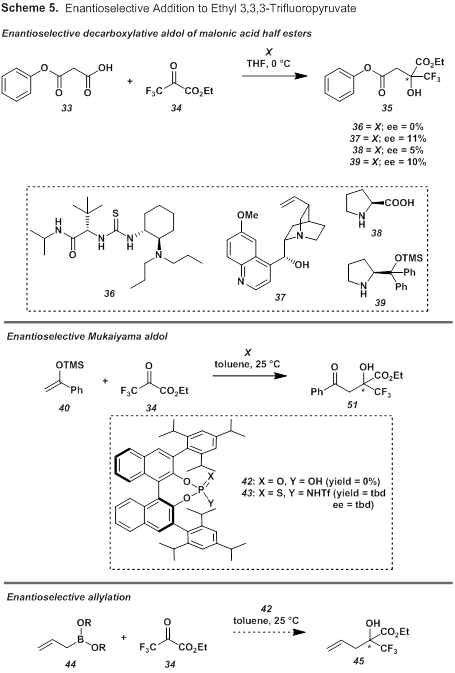Reports: DNI153916-DNI1: Regio- and Enantioselective Trifluoromethylation Reactions through a Combined Directing Group/Chiral Trifluoromethylsilane Strategy
Kimberly Petersen, PhD, University of North Carolina at Greensboro
Goals
Due to the increasing importance of fluorine containing molecules, the goal of this proposal is the generation of enantioenriched compounds which contain a CF3 group at a stereocenter. We proposed the accomplishment of this goal using a novel chiral source of nucleophilic CF3 which could be directed to add in a regio- and stereoselective fashion.
A major challenge to using nucleophilic sources of trifluoromethyl is that the –CF3 anion is unstable and collapses rapidly into a fluoride anion and a stabilized difluorocarbene.1 Because of its commercial availability and easy handling, the Ruppert–Prakash reagent (1 or TMSCF3) employed in combination with an external fluoride source is often the reagent of choice to generate the –CF3 anion.2 A proposed mechanism for the nucleophilic trifluoromethylation of carbonyl compounds is shown in Scheme 1.
The proposal focuses on generation of a chiral silicon based CF3 transfer reagent that would be capable of both 1,2- and 1,4-addition of the CF3 group through a rigid transition state complex.
Progress
Strained silyacycles
Our initial efforts were on the preparation of a chiral CF3 transfer reagent (7 or 8) based on Leighton's strained silacycles (9 and 10, Scheme 2). Chlorosilanes 9 and 10 were readily prepared as previously described3 and then treated with either (a) phenyl trifluoromethyl sulfone and magnesium or (b) trifluoromethylchlorosilane and an initiator. Unfortunately, while we knew we were generating a new silane (structure 7 or 8?) we have yet been able to purify the product (attempts at distillation were unsuccessful). This challenge led us to explore using the crude material in a nucleophilic addition to test the viability of the reagent. To crude 8 we added the known aldehyde substrate 13 and monitored the reaction for formation of the 1,2-addition product. Encouragingly formation of silyl ether 13 was confirmed (in low yield) and with moderate selectivity (ee = 56%). Regrettably extensive efforts to purify either 7 or 8 led only to decomposition. We spent considerable time working with the crude mixture, but never were able to improve the initial yield.
Silicon Centered Chiral Reagent
In addition to our work with the strained silacycle 8, we have moved forward with the preparation of proposed CF3 transfer reagent 15 with silicon centered chirality (Scheme 3). Preparation of reagent 15 from known chiral chlorosilane 144 is anticipated to occur with inversion of stereochemistry.5 Treatment with an initiator would then predictably generate silicate 16 which could be used to deliver CF3 in a stereoselective manner. Synthesis of silane 15 is currently underway following Oestreich's protocol for the synthesis of chlorosilane 14a and 14b.
Chiral Base
Due to our lack of success isolating and purifying chiral reagent 8, we are exploring other ways to generate a chiral silicate such as 21 in situ by utilizing a chiral base as an initiator (Scheme 4). Bases 24–32 were examined for their ability to initiate CF3 transfer with TMSCF3. Unfortunately, the solvent that was conducive for CF3 transfer (DMF) is not typically a good solvent for enantioselective reactions due to its high polarity. Thus, while we were able to show conversion to product in entries 2 and 8, we saw no enantioselectivity.
Side Projects
Alongside our attempts to initiate a program based on nucleophilic addition of CF3, we have explored a variety of methods using organocatalysts and readily available and highly electrophilic ethyl 3,3,3-trifluoropyruvate (34) to generate enantioenriched small molecules (Scheme 5). Decarboxylative addition of malonic acid half ester 33 to pyruvate 34 gave the desired alcohol 35.6 Attempts to prepare alcohol 35 enantioselectively focused on the use of chiral amines and our best result thus far (11% ee) was utilizing tertiary amine 377 A more comprehensive catalyst screen is currently underway. Next, a Brønsted acid catalyzed Mukaiya aldol type reaction of pyruvate 34 with silyl enol ether 39 was attempted.8 Phosphoric acid 42 was not acid enough to initiate reaction, but more active thiophosphoramide BINOL catalyst 43 is currently being prepared to explore in this reaction.9 Lastly, we will attempt an enantioselective allylation of pyruvate 34 following protocol developed by Antilla and coworkers using acid 42.10
Future
Future work will focus on the preparation of silicon centered CF3 transfer reagents 15a and 15b. In addition, we will continue to pursue other strategies for the generation of novel CF3 containing building blocks.
Impact
This grant has had a tremendous impact on my research program. The grant has allowed me to travel to conferences such as the Stereochemistry Gordon Conference in Salve Regina in July of 2014. Undoubtedly, the award was a factor in my laboratory recently being granted funding from the NIH National (GM116041). My graduate student, Jennifer Wilent, who has been supported by this grant has been able to focus on research this past year and has been very productive with 2 publications in preparation. Additionally, undergraduate researchers who participated in summer research have made choices to pursue graduate degrees.
References
(1) Langlois, B. R.; Billard, T.; Roussel, S. J. Fluorine Chem. 2005, 126, 173–179.
(2) Prakash, G. K. S.; Yudin, A. K. Chem. Rev. 1997, 97, 757–786.
(3) Kinnaird, J. W. A.; Ng, P. Y.; Kubota, K.; Wang, X.; Leighton, J. L. J. Am. Chem. Soc. 2002, 124, 7920–7921.
(4) Oestreich, M.; Schmid, U. K.; Auer, G.; Keller, M. Synthesis 2003, 2725–2739.
(5) Hathaway, S. J.; Paquette, L. A. J. Org. Chem. 1983, 48, 3351–3353.
(6) Li, X.-J.; Xiong, H.-Y.; Hua, M.-Q.; Nie, J.; Zheng, Y.; Ma, J.-A. Tetrahedron Lett. 2012, 53, 2117–2120.
(7) Bae, H. Y.; Sim, J. H.; Lee, J.-W.; List, B.; Song, C. E. Angew. Chem. Int. Ed. 2013, 52, 12143–12147.
(8) Mikami, K.; Kawakami, Y.; Akiyama, K.; Aikawa, K. J. Am. Chem. Soc. 2007, 129, 12950–12951.
(9) Cheon, C. H.; Yamamoto, H. Org. Lett. 2010, 12, 2476–2479.
(10) Jain, P.; Antilla, J. C. J. Am. Chem. Soc. 2010, 132, 11884–11886.
















